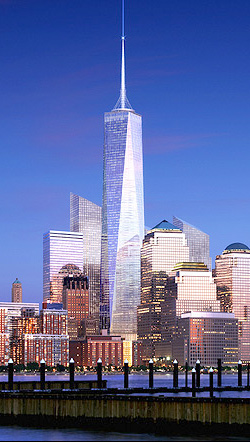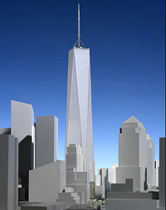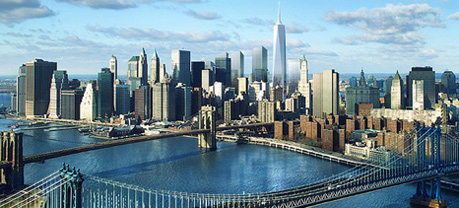The Freedom Tower, Again
 A new design for the Freedom Tower proposed for Ground Zero was presented to the public on June 29, almost a year to the day after Governor Pataki officially kicked off construction by laying the building’s cornerstone on July 4th, 2004. The new design more closely resembles the original Twin Towers than it does the previous designs. The only feature retained from the original idea for the building is its height of 1,776 feet.
A new design for the Freedom Tower proposed for Ground Zero was presented to the public on June 29, almost a year to the day after Governor Pataki officially kicked off construction by laying the building’s cornerstone on July 4th, 2004. The new design more closely resembles the original Twin Towers than it does the previous designs. The only feature retained from the original idea for the building is its height of 1,776 feet.
If the focus of the previous versions of this building was symbolism, the new design is clearly centered on safety. The tower's base is a windowless block of steel and concrete rising 200 feet up from the street. This area will be filled with mechanical equipment, and sheathed with a decorative metal facade. The building will also now be considerably further away from the street.
These changes are meant to make the tower less vulnerable to car or truck bombings, a fear that served as the primary justification for the new design. This spring, the New York Police Department became increasingly vocal in its concerns about security. Officials were eventually forced to address these concerns with major architectural changes.
But the changes have virtually eliminated the ideas of architect Daniel Libeskind, who first conceived the tower in his master plan for Ground Zero in 2002. Libeskind's Freedom Tower was a slender building with an asymmetrical spire, which he intended to evoke the outstretched arm of the Statue of Liberty. This spire rose to a height of 1,776 feet, a tribute to the American Revolution.
In an unhappy collaboration, Libeskind and architect David Childs redesigned the building in December 2003. The new design envisioned a larger tower that twisted to a height of 1,100 feet, with an open-air shaft of windmills surrounded by cables rising 400 feet further. The building was topped by Libeskind’s asymmetrical spire.
The new Freedom Tower does not twist. It has no windmills, and lacks a Statue of Liberty spire. Above the 20-story concrete base, the 77-story building tapers as it rises to 1,362 feet in the air, the same height as Tower Two of the original World Trade Center. Its façade is designed to be reminiscent of the Twin Towers. A centered antenna rises to a total height of 1,776 feet.
By all accounts the building will now be safer. But it seems to have inspired little genuine enthusiasm, at least initially. Michael Goodwin of the Daily News complained of "design fatigue."
New York Times architecture critic Nicolai Ouroussoff saw the design as an indication that political priorities have trumped architectural sensibilities at Ground Zero.
“It is exactly the kind of nightmare that government officials repeatedly asserted would never happen here: an impregnable tower braced against the outside world,” he wrote. “The temptation is to dismiss it as a joke.”
Frank Rich, also in the Times, made the same point more succinctly, renaming the skyscraper "Freedom Bunker."
In the Chicago Tribune, Blair Kamin described the building as “monumentally ordinary,” writing that “it does not turn out to be a persuasive synthesis of armor and aesthetics.”
Newsday’s Justin Davidson said the building was "better than many expected and not nearly good enough.”
Others wondered whether the building can be built at all. Construction is now slated to begin early next year, but the revisions will delay its completion, from the initial promise of 2008 or 2009, to 2010. It is unclear how much the changes will add to the building's $1.5 billion budget.
Looking ahead, skeptics wonder whether there is sufficient demand for the tower’s space, or for the space of any building at Ground Zero. Nearby Seven World Trade Center remains tenantless, even though its construction has gone on without a hitch and is scheduled to be completed in early 2006.
|
|
|
 |
|
|
Computer generated view of the new Freedom Tower design. |
|
Twin Towers, 1973-2001 |
Daniel Libeskind's original Freedom Tower design, December 2002 |
Freedom Tower design, December 19, 2003 |
Â
Living at Home After College
It is, in the view of many members of the upper middle class, a natural rite of passage to go away to college, and then, upon graduation, to move to the big city and live on your own. In fact, though, an increasing number of new college grads are moving back in with Mom and Dad
They have been dubbed the "Boomerang Generation." A new advice book aims at them: "Boomerang Nation: How to Survive Living with Your Parents the Second Time Around." For those finding living back at home difficult, help is available from "I Need My Own Place Self-Action Workbook"
But if some college grads do move back home, many never leave to begin with: They could not afford to reside in the dorms, or did not attend a four-year residential college.
About 30 percent of all New York City college grads aged 21 to 25 live with one or more parents in the metropolitan region, according to an analysis of data from the 2000 census, as do 15 percent of those 26 to 30, and eight percent of those 31 to 35. (See Table 1.)
|
Table 1. Living Arrangements All College Grads 21 to 35
|
||||||
|
Age Categories
|
Parent
|
Roommates or Partners
|
Self
|
Spouse
|
Other Family Situation
|
Total
|
|
21 to 25
|
45,512
|
54,111
|
23,520
|
13,034
|
13,710
|
149,887
|
|
|
30%
|
36%
|
16%
|
9%
|
9%
|
|
|
26 to 30
|
39,366
|
66,550
|
61,005
|
72,069
|
22,882
|
261,872
|
|
|
15%
|
25%
|
23%
|
28%
|
9%
|
|
|
31 to 35
|
17,739
|
33,620
|
53,497
|
96,452
|
19,792
|
221,100
|
|
|
8%
|
15%
|
24%
|
44%
|
9%
|
|
|
Total
|
102,617
|
154,281
|
138,022
|
181,555
|
56,384
|
632,859
|
|
|
16%
|
24%
|
22%
|
29%
|
9%
|
|
But there is a sharp difference between college grads who went away to school and those who did not. When one looks at those aged 23 to 26 who went away to college, only about eight percent are living with their parents. By contrast, almost three-quarters of those who did not go away continue to live at home.
|
Table 2. Living Arrangements and College Location, College Grads 23-26
|
||||
|
|
Live at Home
|
Live on Own
|
||
|
|
Away To College
|
College at Home
|
Away To College
|
College at Home
|
|
Female
|
54%
|
55%
|
58%
|
59%
|
|
Married
|
2%
|
1%
|
14%
|
22%
|
|
Race
|
|
|
|
|
|
White
|
43%
|
54%
|
74%
|
51%
|
|
Black
|
20%
|
18%
|
7%
|
20%
|
|
Hispanic
|
13%
|
15%
|
7%
|
18%
|
|
Employed
|
78%
|
77%
|
84%
|
72%
|
|
Median Income
|
$21,000
|
$25,000
|
$30,000
|
$25,000
|
|
Estimated Number
|
9,127
|
33,265
|
99,890
|
12,353
|
The college graduates in this age group who went away to college and are now living on their own are more likely to be female, married, white, employed and earning more money. Those who boomeranged (went away to college but now live in their childhood home), make less money, are less married, and less white.
Those that boomerang may not enjoy the experience of moving back home, but what about those who never had the chance to leave?
NOTE: This analysis was based upon data from the 2000 Census Public Use Micro-data file, which includes information about where people lived five years before. That information was used to assess who "went away" to college, as well as other characteristics.
Andrew A. Beveridge has taught sociology at Queens College since 1981, done demographic analyses for the New York Times since 1993, and provides expert testimony on a range of cases, including housing discrimination. The opinions expressed are his alone.Â
The Latest Rent Increases
Before the Rent Guidelines Board voted on the latest rent increases on June 21, housing advocates had spent the year pushing for a rent freezefor the nearly one million apartments in New York City that are rent-stabilized. They thought this might be possible this time around, because of the political calculus involved in an election year. Mayor Michael Bloomberg, running for re-election, appoints the members of the board, which are made up of five “public members,” two who represent landlords and two who represent tenants.
It is possible to say that the Rent Guidelines Board came closer than it has ever come to a rent freeze, because, for the first time in the board’s 35-year-old history, one of the five public members of the nine-member board actually voted for a rent freeze.
But ultimately, the Rent Guidelines Board voted 6 to 3 to allow landlords a 2.75 percent increase on a one-year lease and a 5.5 percent increase on a two-year lease. This is close to the low end of what they had been contemplating since April.
Martin Zelnik, the public member who voted for the rent freeze, said he had “no clue” he had made history. Even though the rents were in fact raised, “I think symbolism is important. The public should know that public members are being sensitive to the public’s concerns.”
In discussion of the motion to increase rents, Zelnik said the board’s annual deliberations shortchange tenants in the city because the board does not consider the broader impact of rent increases on tenants.
“The system is inherently unfair to evaluating the tenants’ side,” Zelnik said. “It doesn’t take into account the quality of life costs for tenants. We have heard very, very little about the issues facing tenants,” he said, citing increases in transit fares, college tuition, food and other items as examples.
After the meeting he said he voted for the increase because it was the best he feared that voting “no” could have led to a higher increase. “You try to arrive at the best level you can,” he said. “I was hoping it would be lower, but it could have been higher.”
Zelnik’s stand in favor of a rent freeze won him support among advocates -- but not much.
“It’s so hypocritical of these public members to say we have an affordable housing crisis and we should study this, and then go ahead and vote for an increase,” said Michael McKee of Tenants and Neighbors.
But board members differed on what role the board plays in addressing the crisis.
While Marvin Markus, the board’s chairman, indicated in his remarks at the vote that the board was charged with keeping rents affordable, the board as a whole apparently believes that allowing landlords to recoup increased operating costs trumps tenants’ financial issues. The city’s record level of homelessness did not move one landlord representative, Howard Lubell. Among other arguments, landlords contend that if rents are not increased adequately, they do not have enough money to pay for building repairs and maintenance.
“We have 38,000 homeless people out of 8 million people in New York,” Lubell said after the vote. “That is not solved by creating more distressed housing.”
Days before the vote, housing advocates had promoted a set of provisos that would have ruled out increases in rents for certain rent stabilized apartments. But the provisos, introduced as a “friendly amendment” by Zelnik during the meeting, were flatly rejected by Markus, who deemed them unfriendly.
One proviso would have given a smaller increase in rent on apartments in buildings where 25 percent or more of the apartments had been decontrolled. Rent stabilized apartments can be decontrolled if their rents reach $2,000 and they are vacated, or if they are $2,000 per month or more and the household income is $175,000 or more for two consecutive years.
Markus also deemed “unfriendly” a second Zelnik amendment that would have given owners of buildings with 10 or fewer apartments where an apartment rents for $400 or less a higher increase in rent.
If tenant advocates were left seething at the outcome of the board meeting, an optimist could discern at least one more positive sign. Everyone on the board this year agreed that the city faces an affordable housing crisis. This is a change from the past. A year ago, the board’s chairman flatly said no such crisis existed.
Joe Lamport is the assistant director of the City-Wide Task Force on Housing Court, a coalition of community housing organizations. Â










